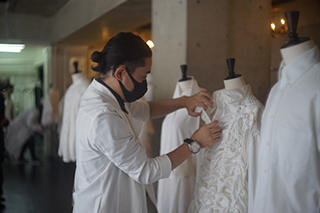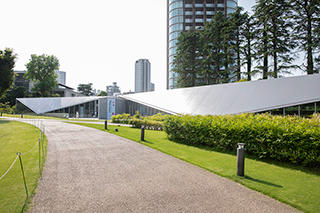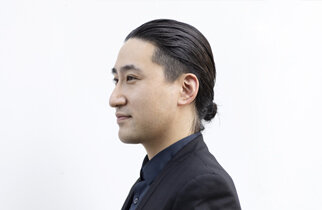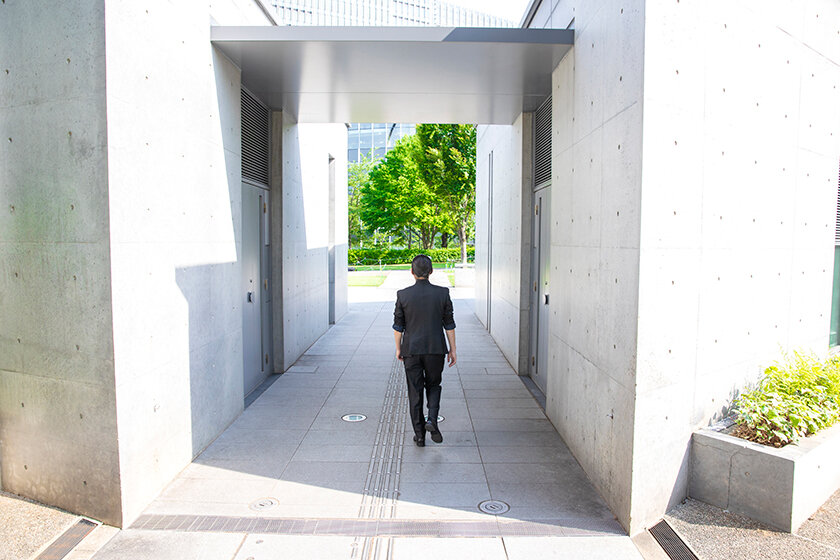
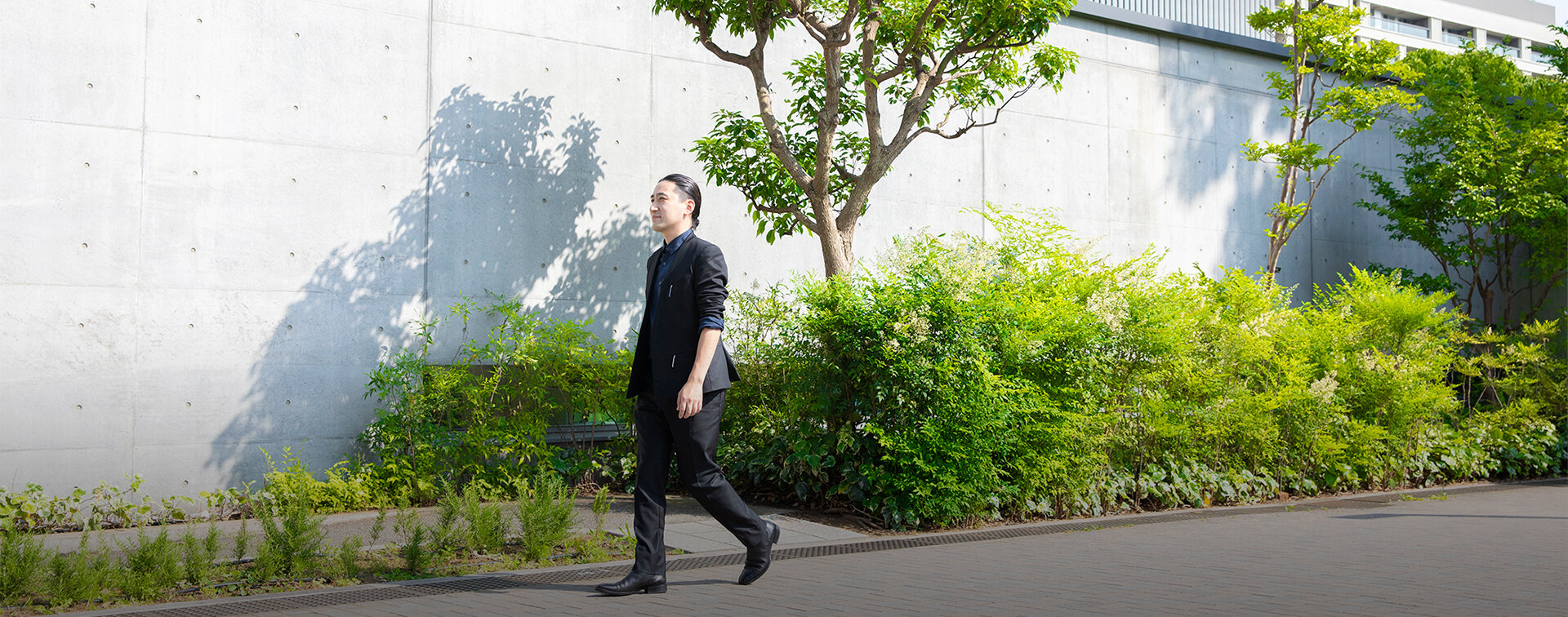
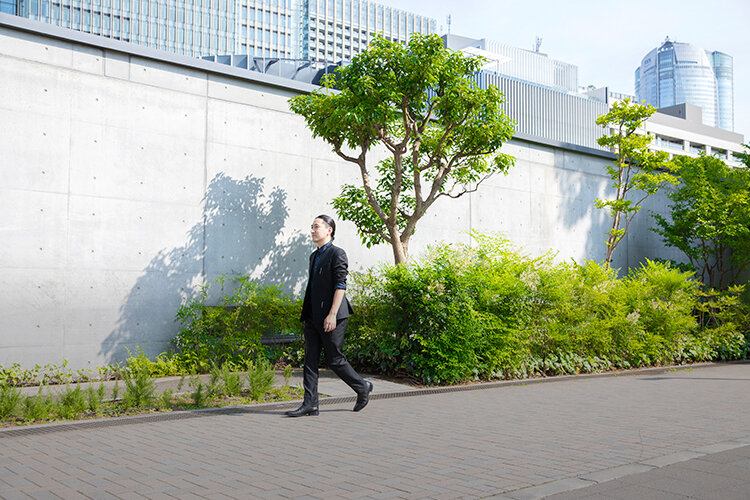
INTERVIEW
118
Yuima NakazatoFashion Designer
Building a Clothing Recycling System into Urban Development
Make fashion designers a part of planning cities.
Yuima Nakazato is the only Japanese fashion designer currently active on the Paris haute couture collection scene. Through his extensive experience designing costumes for globally prominent artists, Nakazato decided that he wanted to find ways to bring one-of-a-kind garments to more people. We interviewed him on the fundamental philosophy that drives his work, why he chooses to actively integrate unique technology into his production process, what he thinks about the fashion industry's recent trend towards sustainability, and how he envisions clothing to function in future cities. Through it, we saw the philosophies of a fashion designer who constantly pursues the ideal relationship between garment and person, as well as between the wearer and the designer.
Creating a world where more people can wear "clothing made for them"
I studied fashion at the Royal Academy of Fine Arts Antwerp, then returned to Tokyo and started my career as a fashion designer. Early on, I had the opportunity to custom design a costume for a musician (The Black Eyed Peas vocalist Fergie), and that became the foundation for the way I make clothes. She lived in Los Angles and I had never met her in person, so I designed the clothes imagining what would look good on her. The first time we met was at the fitting, where I had her try on the outfit. She liked the costume very much, and ended up ordering the same outfit from me multiple times. Through that entire process, I discovered how fascinating it is to design clothes with the wearer in mind. Not only was the costume a perfect fit, I designed it imagining what the wearer's background, personality, and even her lifestyle might be like, and she was very happy with the result. That process is my ideal for how clothing should be, and I started thinking that the world would be a richer place if more people could wear clothes made in that way.
Meanwhile, most clothes worn today are at the other extreme, with garments generally being mass-produced for an unspecified large number of people. It's incredibly rare for people to wear something that not only fits them size- and comfort-wise, but also "suits them" in every sense of the word. It is an experience reserved for a very limited population worldwide. What motivates me is actually trying to figure out how to deliver that experience to more people.
In the sense of "handmade garments," clothes that mothers make for their children are "made-to-order," and a suit made to fit by a local shopping street tailor is also "made-to-order," so it's arguably a fundamental practice that has always existed. The process of the creator (a.k.a. the "designer") and the wearer making clothes in close collaboration may seem special nowadays, but it's actually at the root of what fashion is about. By combining that fundamental concept with new ideas and technologies may help create a world where more people can get access to clothes that enrich their lives. Technology can range from cutting-edge to those that have been passed down from ancient times. I want to combine all kinds of technology in order to realize my vision, so I'm always on the lookout for information on new and old technology from all over the globe.
Futuristic clothing that combines kimono and tailoring techniques
Looking for solutions within fashion alone narrows my perspective, so I value communication with people from other industries. Recently, I have been particularly interested in a material called Brewed Protein, which is made from manmade protein developed by the company Spiber. The textile's biggest characteristic is the ability to control its contraction property, which I want to take advantage of in making clothes. To be more precise, fabric is basically rectangular while the body has three-dimensional curves, which means the fabric needs to be cut in curved patterns to fit the human body. But cutting curved shapes from a rectangular piece of cloth inevitably results in wasted material.
BREWED PROTEIN
A manmade protein material made by Spiber, a biotech venture company headquartered in Tsuruoka, Yamagata Prefecture. Unlike synthetic fibers made from petroleum, the material uses protein made from a microbe fermentation process. It is gaining widespread attention especially from the apparel industry as a sustainable material. Nakazato collaborated with Spiber and THE EUGENE studio on the YUIMA NAKAZATO Autumn/Winter 2019-2020 collection, where he used Brewed Protein for every outfit.
photo:SHOJI FUJII
Meanwhile, Japanese kimono uses rectangular fabric as-is to enrobe the body, which produces no waste, but results in a shape that doesn't suit the body. Using curves that follow the bodyline is a European tailoring technique, but I think it's possible to use the Brewed Protein's flexible properties to achieve an idea that combines kimono and tailoring techniques. As of now, we are able to precisely control the way the fabric moves using digital programming, a technology I have used in my Paris collections. My goal is to evolve and scale this technology so that it can be delivered to more people.
Reducing the distance between the creator and the wearer leads to sustainability
Just like in other industries, fashion has seen a rapid acceleration of the sustainability trend in recent years. Many people have been put in tough situations because of the novel coronavirus, giving them time to think about what's really important in their lives. I think that has made people put deeper thought into the need for sustainability. But in some cases it is relegated to a buzzword or an abstract image of the concept, even though sustainability is actually much more complex and challenging the more one faces it. There's no easy solution, but an important key is using one's imagination. Where does clothing come from in the first place, and where does it go? In the process of buying clothes off of a retail store shelf, wearing it, and eventually disposing of it, it's hard to visualize what happens before and after. But there are actually all kinds of steps in the upstream process such as fabric production, processing, and sewing that in some cases cut across regions or even countries. This is also true after disposal. I think it's great that in thinking about sustainability, the people who wear the clothes are also starting to think about these kinds of processes.
Of course, it's important to consider sustainability from a fashion designer's point of view as well. Simply choosing a sustainable material isn't enough. There are sustainability-conscious materials available all over the world, and being able to discern the best one to choose is a necessary skill. It's also important to reevaluate the production process to pinpoint issues, such as if there is any waste when cutting out patterns or whether the labor costs match the processing methods. Moreover, no matter how good a material the designer chooses and produces clothes with the best possible production process, there is no point if the consumer does not get the designer's intent and only wears the garment for a short time and dispose it.
I want to make clothes that people care about and wear for a long time. I want to create clothes--delicate ones even--that make people want to take good care of and wear for long, even if it means getting them mended or altered. So how can I manage to make clothes like that? I think the answer is to reduce the distance between the designer, who makes the clothes, and the person who wears the clothes. Instead of a one-sided communication of the designer's intent and story, building a reciprocal relationship where the wearer can get an idea of what the creator is like is the kind of communication that designers need to think about.

Extracting our forerunners' philosophies to connect to the future
Kimono are meant to be passed down through generations and worn for a long time, and I'm impressed how its simple design allows it to be worn by all sorts of body types with minimal alterations. There's basically no concept of size in a kimono, so anybody can wear it, or in other words it's not made to fit anybody. I think that's an extremely futuristic concept. With no concept of size, it's a universal design that can be worn by any individual. However, modern lifestyles make the kimono impractical for daily use, so I'm always trying to figure out a new form of clothing that inherits the philosophy of the kimono.
One tends to look to cutting-edge technology when thinking about the future, but many of the ideas devised by our forerunners were incredibly epoch-making, so there is a wealth of tips to be taken from the past. Even if past techniques cannot be incorporated as-is, we should be able to extract their underlying philosophies to create designs that suit modern lifestyles. I believe it is part of a designer's job to connect the past, present, and future in this way.
A made-to-order process that gives shape to wishes communicated online
I always wanted to be able to deliver one-of-a-kind clothing to more people, but when the new coronavirus hit in the midst of navigating various research and development projects, it suddenly became difficult to continue creating in teams and my atelier ceased to function. Then I saw musicians and other artists streaming music out of their homes on online video-sharing platforms, I thought maybe fashion designers could do something as well. That's what got me started with Face to Face, a made-to-order project that reimagines and redesigns customer-owned white shirts. I was originally planning to go forward with the idea a little bit later in the future so parts of it were still unrefined, but I started it in hopes of delivering what I could for people to enjoy fashion in these disheartening times.
Face to Face
A charity made-to-order service launched on May 1st amidst Japan's nationwide state of emergency, born from Nakazato's desire to "do what he could to uplift spirits through fashion." Through online dialogue with customers, Nakazato redesigned their white shirts into one-of-a-kind garments.
YUIMA NAKAZATO Co., Ltd.
I had no idea what kind of reaction I would get, but I received lots of orders from both within Japan and from overseas. I really wanted to take all of the orders, but I narrowed the selection down to 25 by lottery and talked to each person online to hear their particular tastes and memories about their garments. In order to learn more about each person, I asked a few questions from my end such as "Where do you want to go when the coronavirus settles down?" and "What kind of clothes do you usually wear?" Even a shirt that has been stashed deep in the closet has all kinds of memories attached to it, infusing it with a value that is immeasurable by its original price tag. I definitely felt the responsibility of handling something of great importance.
A usual made-to-order item involves meeting the customer directly to take measurements, but this time I went through the process of hearing the customer's thoughts online and seeing them wear the shirt before the alteration in order to work on the transformation. Really focusing on each person to come up with designs requires a lot of energy. Some may call it inefficient. But I hoped that this endeavor would be a good chance for the customers to start taking care of their clothes to wear them for a long time. Some of the participants in this project said they wanted to use the opportunity to be "reborn," and I was grateful to see the diversity of thought behind the many requests I received. It was a very good experience for me, as well.
Delivering an experience that surrounds clothing becomes the designer's role
Nowadays, anyone who wants to polish their fashion sense simply needs the internet to get instant access to decent information, which make it much harder to stand out from the crowd. I imagine that the work of a fashion designer will become increasingly like a service industry job from here on out. Clothing will always be at the core, but the designer's role may shift towards delivering a kind of experience that surrounds clothing. In that sense, I think fashion show-type events will continue to be relevant to offer experiences. However, perhaps they will no longer be limited to fashion professionals but become more open to general consumers.
In pre-coronavirus times, the speed of the entire fashion industry was accelerating rapidly with more frequent output, demanding more efficient production in short time periods. I think the move towards reconsidering that trend and putting more time and energy into each item to improve quality is a wonderful thing for the creative world. Having to make something good in a short timeframe inevitably requires combining preexisting items to make it look "new" instead of creating something from scratch. The kind of creation that fundamentally revisits the entire process from material development on up is impossible to do in the short term. In that sense, I sometimes envied the creation processes I see in other industries that allow years of development instead of months, such as architecture and product design. But I'm hoping that the coronavirus situation will be an opportunity for fashion to also allow a slower designing process that puts more focus on quality.
Haute couture is like the Formula One race in automobile terms, a place to present the most beautiful product currently possible, made with the finest technology available today. It's important as a place to show a designer's skill, but I also think the process of creating the garment through dialogue between the designer and customer is ideal in itself. That's why I'm interested in the potential of having more services and products that encompass the philosophy of haute couture. Updating just one section of the clothes-making process won't result in much change, so this will require a comprehensive overhaul. It's the designer's role to act as a bridge in that updating process, and I hope to help connect the specialized sections that currently operate separately.
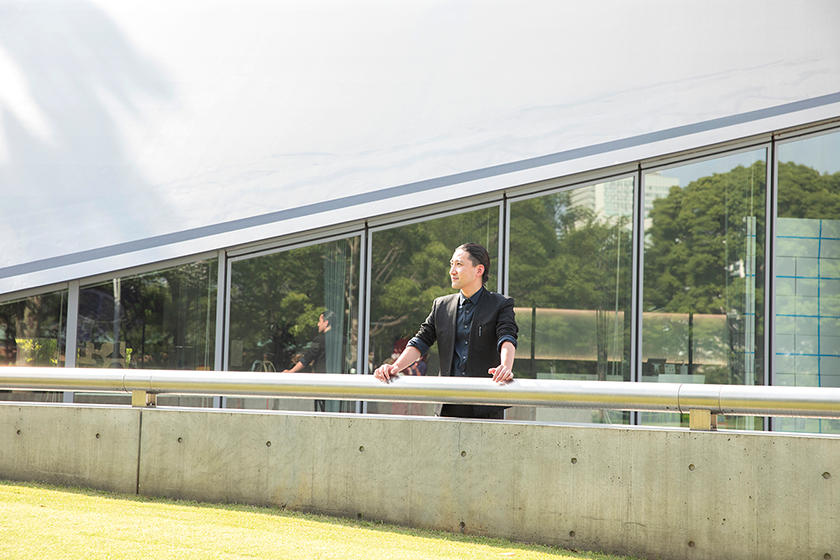
The ideal way clothes functioned in an Edo period city
At 21_21 DESIGN SIGHT Gallery 3, I had the opportunity to hold an exhibition in 2018 entitled HARMONIZE, where I proposed all kinds of ideas for future clothing. Partly because of the location, I had a lot of visitors with keen artistic sensibilities, which resulted in a lot of meaningful exchanges where I got to hear interesting ideas about future clothing and what kinds of clothes people wanted to wear someday. The exhibition was also memorable because Mr. Issey Miyake came to see it in person. He reflected back on the '60s and '70s when he transitioned from haute couture to prêt-à-porter, and told me of his own experiences creating prêt-à-porter lines through the ages. He also mentioned, "Maybe prêt-à-porter is about to transition to the next stage as well," which I found very encouraging to hear.
YUIMA NAKAZATO Exhibition - HARMONIZE
An exhibition by Nakazato at 21_21 DESIGN SIGHT Gallery 3 in February 2018, which showcased his latest collection from the January 2018 Paris Haute Couture Fashion Week, its manufacturing system, and new products made using Ultrasuede®PX, an environmentally friendly suede texture fabric invented by Toray.
Hosted by: Toray Industries, Inc.
photo:Yasuyuki Emori
21_21 DESIGN SIGHT
An exhibition facility dedicated to design located in Tokyo Midtown. It holds regular exhibitions as a place for nurturing understanding and interest for design. Currently, an exhibition entitled "Secret Source of Inspiration: Designers' Hidden Sketches and Mockups" with Kinya Tagawa as Exhibition Director is held in Gallery 1 & 2 (until September 22, 2020).
There's a project I have always wanted to try in the context of a city. When thinking about planning cities from an urban development context, transportation, architecture, and infrastructure are obvious factors to consider, but I assume not that many people consider the role of clothing or fashion designers. But if you take a look at the Edo period, garments went through highly efficient cycles in the cities. More specifically, there were tanmono shops that sold fabrics, kimono shops that made garments from those fabrics, people who went around collecting garments for repair, and those who took garments apart. The garments that were no longer suitable for use would end up as rags for cleaning, then eventually burned so that the ashes could be used for fertilizer and nothing went to waste. Partly from what I imagine through the research I have done, I get the impression that anyone anywhere could make use of these services, and kimono existed in synchronization with how cities worked.
I wonder if we might be able to construct that kind of cycle for clothing in modern times as well. Of course, there are fabric shops and clothing repair shops today, but there really are not that many, partly because only a small portion of people make clothes. In addition, they say that recycling clothes is particularly difficult compared to paper because all the different materials included such as buttons and fasteners means the process requires much more energy and cost. Another issue is that the people who make clothes, the people who repair clothes, and the people who recycle are not connected in any way. If we could design a system that incorporated all of these factors together, I think we could set up an efficient cycle. It's a large-scale idea, but I'm sure that including a fashion designer's perspective for urban planning would enable much more interesting initiatives.
Editor's thoughts
The desire to deliver haute couture to more people initially seemed like a contradictory way for clothes to function, but listening to Mr. Nakazato, who has the inquisitiveness of a researcher, made me think that his wish isn't fantastical at all. It's exciting to imagine a future where everyone wears one-of-a-kind clothing, and it reminded me that this excitement is the element that is so important in fashion. Clothing is one of the basic necessities in life, and I fully agree that more commitment is necessary in thinking about how they should function in cities. Perhaps a future where fashion makes cities more exciting is actually right around the corner.(text_ikuko hyodo)
(Photos provided by 21_21 DESIGN SIGHT)
RANKING
ALL
CATEGORY





